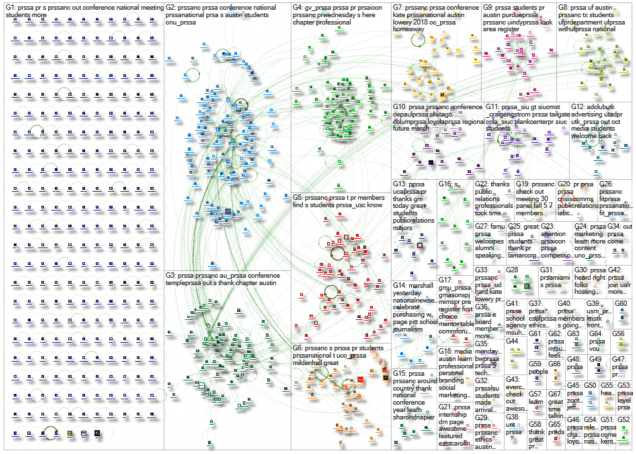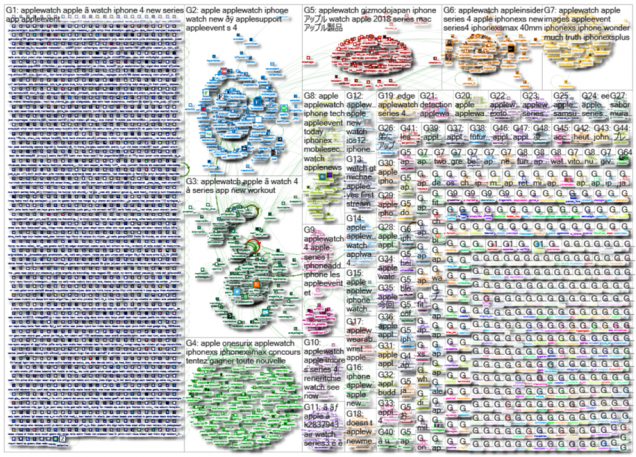Infomediation is defined by Nikos Smyrnaios as “the set of socio-technical mechanisms such as software, services and infrastructure that provide internet users with all types of information online and connect them with other users” (Smyrnaios, 2018). If we consider a platform like Twitter, we can see the role infomediation plays on this particular social network. Twitter is now one of the “main infomediaries on the mobile internet along with Google” (Smyrnaios, 2018). While it is true that Twitter has provided a “wider choice of distribution channels and rekindles competition over infomediation platforms”, it also “reinforces the oligopolistic dynamics of the mobile internet, where the concentration of audiences and uses is much stronger than on the web” (Smyrnaios). This brings into consideration the conversation and group network structures that exist on Twitter. These structures are visualized in the form of network maps, which can exist as one of six distinct types. We will examine two types of these network maps: Community Clusters and Brand Clusters.
Network maps display vertical integration in action. “Vertical integration is defined as bringing together a complementary set of business activities that constitute a production chain under the same decision-making power” (Smyrnaios, 2018). In other words, it is the combination of multiple stages of production. Today, the internet oligopoly successfully engages in vertical integration by being “present in four subsets and markets that are part of the infomediation infrastructure: operating systems, consumer electronics, telecommunications networks and data centres” (Smyrnaios, 2018). We will explore the role of vertical integration in the following network maps.

https://nodexlgraphgallery.org/Pages/Graph.aspx?graphID=170775
This network map is an example of a Community Cluster. “Community Clusters are the defining quality of these networks: they feature a collection of medium sized groups, rather than a crowd of mostly unconnected Twitter users” (Smith, Rainie, Shneiderman, & Himelboim, 2014).The community examined here is the PRSSA (Public Relations Student Society of America).This network map demonstrates a shared topic among nodes, which are individual actors within the network. However, we can also see that the nodes, sometimes also referred to as vertices, have different focuses. For example, we can see contrasting hashtags such as #schoolpr vs #crisispr. The shared topic remains PR, but the variation on focus is evident. This is similar to the findings of another Community Cluster map studied by Smith et al. These hashtags and also the URLs used by the PRSSA community are affordances that Twitter users are engaging in. Because of the limited text space on the platform, hashtags and links are an effective way to communicate despite Twitter’s limitations. We can also see from the edges on the map that many people in each of the clusters are connected with people beyond just their own group. The “replies-to” and “mentions” affordances of Twitter are also being engaged with as we see edges demonstrating each of these on the network map.

https://nodexlgraphgallery.org/Pages/Graph.aspx?graphID=170769
The map above is an example of a Brand Cluster. “Brand Cluster networks often have very low density and many isolated participants”(Smith, Rainie, Shneiderman, & Himelboim, 2014). We can see in this map that there is a “large population of disconnected isolates” and that “smaller clusters of connected groups have formed” just as Smith et al. found in their examination of Brand Clusters.“Advertised products, public events, and major news events are likely to have this network structure” (Smith, Rainie, Shneiderman, & Himelboim, 2014). This is demonstrated in this map of a Brand Cluster as the clusters have formed around an advertised product: the apple watch. Again, users are engaging with the affordances of hashtags. The top hashtags are #applewatch and #apple and many users are mentioning @apple and @bestwatchapps in their posts. “In a Brand Cluster network many people are likely to mention the brand without having any connection to other people who also mention the brand” (Smith, Rainie, Shneiderman, & Himelboim, 2014). This is displayed in this map as there is an evident lack of edges between clusters in comparison with the Community Cluster network map—this reinforces the idea of disconnected isolates.
Nikos Smyrnaios discusses the idea of platformisation, which is often treated as a “progressive and egalitarian arrangement”, but it in fact “masks the growing privatization and commodification of utilities and infrastructures” (Smyrnaios, 2018). If we consider the influence of Twitter as a source for information, we should begin questioning whether or not it is and continues to be a “progressive and egalitarian arrangement”, or if something is happening here that we cannot yet see. If we consider how Twitter uses infomediation and vertical integration, we can begin to gain a better understanding of the true nature and influence of the platform.
By looking at both of these graphs we can see vertical integration at play as Twitter dominates information dissemination by providing a platform for countless sources, a foundation for conversation, and a link between users of completely different backgrounds. Twitter allows its users to write, edit and publish their work, as well as reply to and mention the work of others—it has combined multiple stages of production rendering other sources of information unnecessary and contributing the oligopolistic control of the internet. We can see from these maps how Twitter has taken advantage of infomediation to provide information and connect users across the platform. It is evident from the network maps that exist today that Twitter has done this successfully by the number of users discussing all topics of conversation and providing all forms of information. In this case, vertical integration has led to the success of Twitter’s infomediation and the possibility of the platform positioning itself in the internet oligopoly.
Rainie, Lee. “Part 2: Conversational Archetypes: Six Conversation and Group Network Structures in Twitter | Pew Research Center.” Pew Research Center: Internet, Science & Tech, Pew Research Center: Internet, Science & Tech, 24 Feb. 2014.
SMYRNAIOS, NIKOS. INTERNET OLIGOPOLY: the Corporate Takeover of Our Digital World. EMERALD GROUP PUBL, 2018.